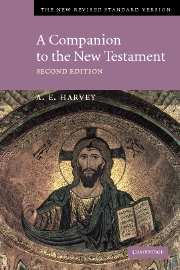Book contents
- Frontmatter
- Contents
- Preface
- Preface to the First Edition (1970)
- THE NEW TESTAMENT
- THE GOSPELS
- THE ACTS OF THE APOSTLES
- LETTERS
- Romans
- 1 Corinthians
- 2 Corinthians
- Galatians
- Ephesians
- Philippians
- Colossians
- 1 Thessalonians
- 2 Thessalonians
- 1 Timothy
- 2 Timothy
- Titus
- Philemon
- Hebrews
- James
- 1 Peter
- 2 Peter
- 1 John
- 2 John
- 3 John
- Jude
- THE REVELATION
- Old Testament References
- Index
- Frontmatter
- Contents
- Preface
- Preface to the First Edition (1970)
- THE NEW TESTAMENT
- THE GOSPELS
- THE ACTS OF THE APOSTLES
- LETTERS
- Romans
- 1 Corinthians
- 2 Corinthians
- Galatians
- Ephesians
- Philippians
- Colossians
- 1 Thessalonians
- 2 Thessalonians
- 1 Timothy
- 2 Timothy
- Titus
- Philemon
- Hebrews
- James
- 1 Peter
- 2 Peter
- 1 John
- 2 John
- 3 John
- Jude
- THE REVELATION
- Old Testament References
- Index
Summary
Like the First Letter of Peter, this letter claims to have been written by the apostle, in this case shortly before his death. But a number of factors makes it difficult to accept that Peter could really have been the author. For one thing, extensive use is made of phrases and ideas which appear in the Letter of Jude – would the historical Peter have borrowed from a fellow apostle? For another, there is a reference to the letters of Paul, which seems to presuppose that there already existed a collection of them bearing the authority of scripture (3.15–16) – and this is unlikely to have been the case in Peter's lifetime. In addition, the sophisticated style and Hellenistic character of the letter are not what one would have expected from a Galilean companion of Jesus. It seems therefore probable that the letter is one of those which appear to have been written after the death of their supposed authors and which supported their claim on the attention of Christians by invoking the authority of one of the apostles. In this case, if it was written from Rome, Peter's would have been the most appropriate name and authority to invoke. It can be plausibly dated to the last part of the first century ce. By the end of the third century it had been hesitantly accepted into the canon of the New Testament.
- Type
- Chapter
- Information
- A Companion to the New Testament , pp. 750 - 756Publisher: Cambridge University PressPrint publication year: 2004

